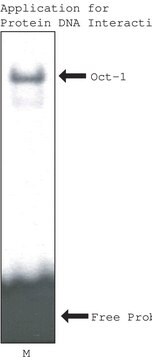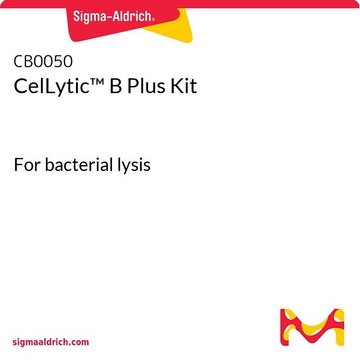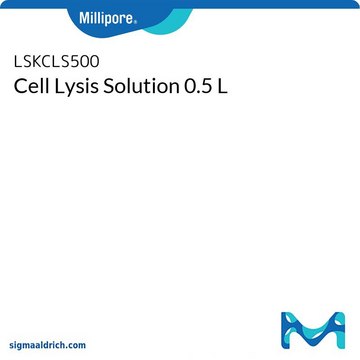B7435
CelLytic™ B Cell Lysis Reagent
For bacterial cell lysis, standard strength
Sinonimo/i:
Cell lysis reagent
Autenticatiper visualizzare i prezzi riservati alla tua organizzazione & contrattuali
About This Item
Prodotti consigliati
Livello qualitativo
Forma fisica
solution
Cerchi prodotti simili? Visita Guida al confronto tra prodotti
Applicazioni
CelLytic™ B Cell Lysis Reagent has been used for cell lysis for the extraction of coenzyme Q10, recombinant Src kinase associated phosphoprotein 1- glutathione S-transferases (GST) fusion protein and human α-synuclein.
A proprietary, non-denaturing formulation of zwitterionic detergents used for the lysis of bacterial cells and extraction of recombinant proteins.
Caratteristiche e vantaggi
- Higher protein extraction efficiency than traditional methods such as sonication and lysozyme
- Scalable for 1 to 25 grams of bacterial cell paste
- No interference with downstream applications such as affinity chromatography, IP, and Western blotting
- Compatible with protease inhibitors, inhibitor cocktails, chaotropes, salts, chelating agents and reducing agents
Altre note
Detergent blend formulated in 40 mM Trizma® HCl (pH 8.0).
Note legali
Covered by US Patent No 7,282,475 B2 and are sold for research use only. Commercial use requires addtional licenses.
CelLytic is a trademark of Sigma-Aldrich Co. LLC
Trizma is a registered trademark of Merck KGaA, Darmstadt, Germany
Prodotti correlati
N° Catalogo
Descrizione
Determinazione del prezzo
Avvertenze
Warning
Indicazioni di pericolo
Consigli di prudenza
Classi di pericolo
Eye Irrit. 2 - Skin Irrit. 2
Codice della classe di stoccaggio
12 - Non Combustible Liquids
Classe di pericolosità dell'acqua (WGK)
WGK 3
Punto d’infiammabilità (°F)
Not applicable
Punto d’infiammabilità (°C)
Not applicable
Dispositivi di protezione individuale
Eyeshields, Gloves, type ABEK (EN14387) respirator filter
Certificati d'analisi (COA)
Cerca il Certificati d'analisi (COA) digitando il numero di lotto/batch corrispondente. I numeri di lotto o di batch sono stampati sull'etichetta dei prodotti dopo la parola ‘Lotto’ o ‘Batch’.
Possiedi già questo prodotto?
I documenti relativi ai prodotti acquistati recentemente sono disponibili nell’Archivio dei documenti.
I clienti hanno visto anche
Ken Motohashi
BMC biotechnology, 15, 47-47 (2015-06-04)
Seamless ligation cloning extract (SLiCE) is a simple and efficient method for DNA assembly that uses cell extracts from the Escherichia coli PPY strain, which expresses the components of the λ prophage Red/ET recombination system. This method facilitates restriction endonuclease
Monika Raab et al.
Scientific reports, 9(1), 10462-10462 (2019-07-20)
While the immune cell adaptor protein SKAP1 mediates LFA-1 activation induced by antigen-receptor (TCR/CD3) ligation on T-cells, it is unclear whether the adaptor interacts with other mediators of T-cell function. In this context, the serine/threonine kinase, polo-like kinase (PLK1) regulates
Prion-like seeding of misfolded alpha-synuclein in the brains of dementia with Lewy body patients in RT-QUIC
Sano K, et al.
Molecular Neurobiology, 55(5), 3916-3930 (2018)
Kazunori Sano et al.
Acta neuropathologica communications, 9(1), 182-182 (2021-11-14)
Serine 129 (S129) phosphorylation of α-synuclein (αSyn) is a central feature of Lewy body (LB) disease pathology. Although the neighboring tyrosine residues Y125, Y133, and Y136 are also phosphorylation sites, little is known regarding potential roles of phosphorylation cross-talk between
Ca2+ increases the specific coenzyme Q10 content in Agrobacterium tumefaciens
Ha SJ, et al.
Bioprocess and Biosystems Engineering, 32(5), 697-700 (2009)
Il team dei nostri ricercatori vanta grande esperienza in tutte le aree della ricerca quali Life Science, scienza dei materiali, sintesi chimica, cromatografia, discipline analitiche, ecc..
Contatta l'Assistenza Tecnica.













